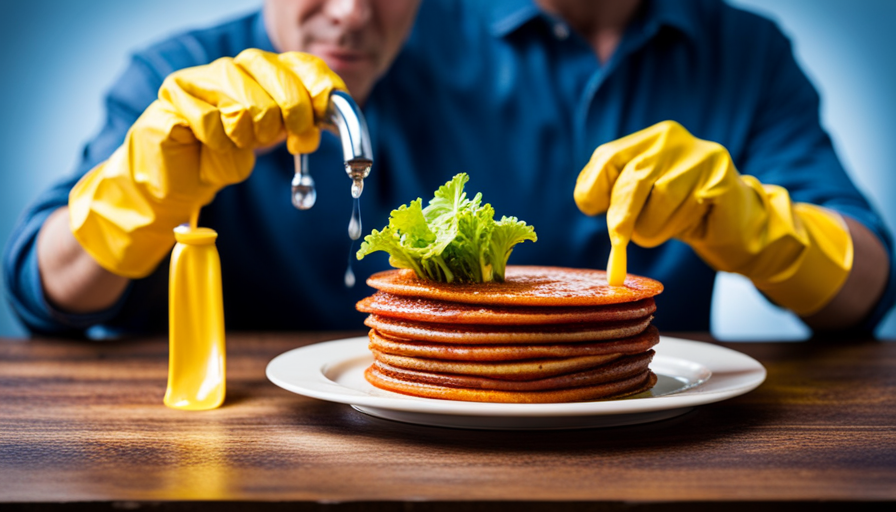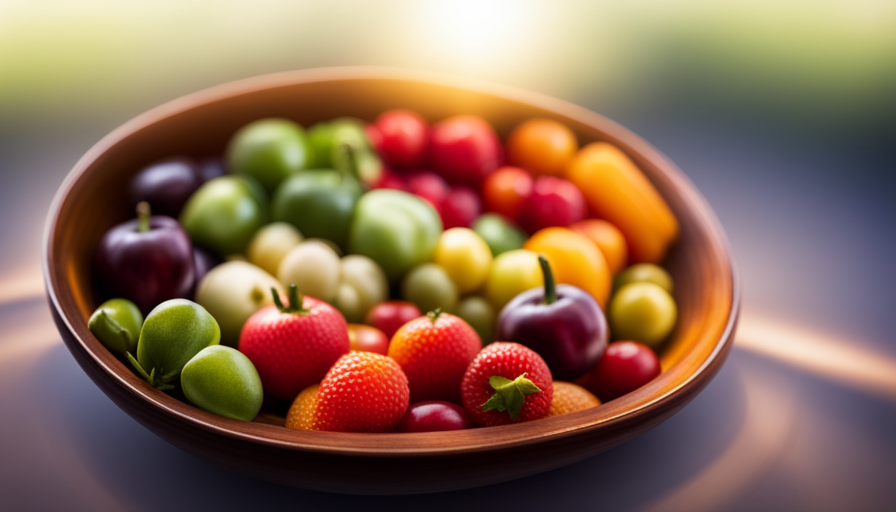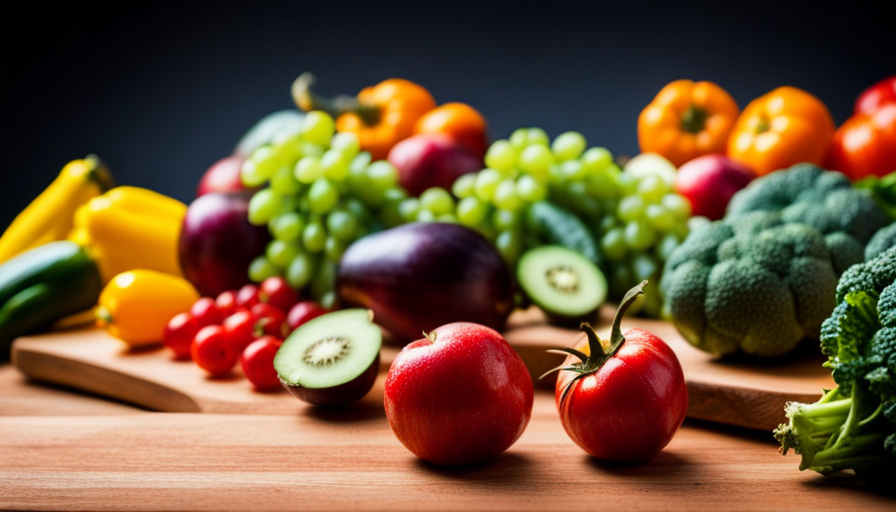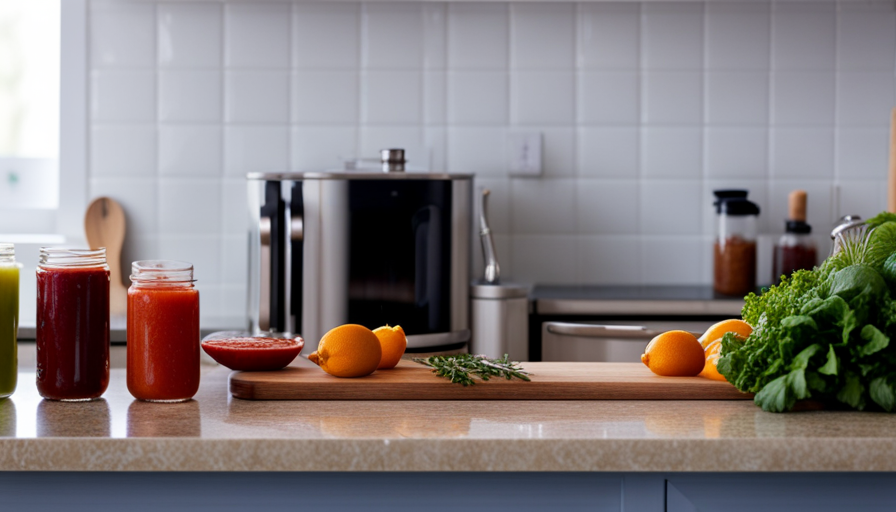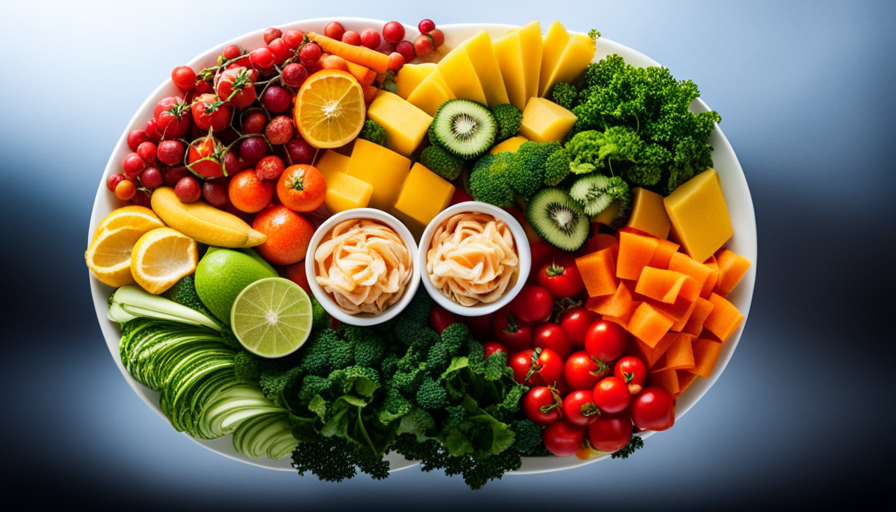Are you ready to face the aftermath of a culinary adventure? Washing dishes that have been exposed to raw ingredients is like navigating a wild jungle. Each dish holds a world filled with remnants of flavors and textures. But fear not, as I am here to guide you through this cleaning mission with precision and ease.
Imagine yourself as an explorer, armed with the power of hot water and soap, venturing into the unknown, ready to conquer any remnants left behind by raw food. This article will equip you with the necessary steps to ensure that your plates are not only clean but also free from any potential harmful bacteria.
From scraping off excess food to paying attention to every nook and cranny, we will leave no stone unturned. We will dive into the depths of sanitizing with hot water or a dishwasher, ensuring that every last trace of raw food is eradicated. And finally, we will conquer the art of drying and storing clean plates, ready for your next culinary escapade.
So, put on your apron and let’s embark on this cleaning adventure together, ensuring the utmost food safety for you and your loved ones.
Key Takeaways
- Scrape off leftover food particles before washing to remove harmful bacteria.
- Rinse plates under running water to remove soap and food particles, avoiding shared towels to prevent cross-contamination.
- Soak plates in hot, soapy water at a temperature of at least 120°F (49°C) to sanitize and remove stubborn residue.
- Thoroughly rinse plates with warm water to remove all traces of raw food and prevent cross-contamination.
Preparing for Washing
Before washing the plates, make sure to scrape off any leftover food particles. This is an important pre-washing step as it helps prevent cross-contamination. When raw food comes into contact with other dishes, it can transfer harmful bacteria and cause foodborne illnesses.
To properly prepare for washing, gather all the plates used for raw food and place them near the sink. Fill the sink with hot, soapy water. Use a dish brush or sponge to scrub the plates, making sure to remove any visible residue. Pay extra attention to the areas where the raw food was in direct contact.
Rinse the plates thoroughly under running water to remove any remaining soap and food particles. Avoid using a shared towel to dry the plates, as this can also lead to cross-contamination. Instead, let them air dry or use a clean paper towel.
By following these pre-washing steps, you can ensure that your plates are thoroughly cleaned and free from any harmful bacteria.
Scraping off Excess Food
After scraping off the excess, you’ll be surprised to learn that nearly 60% of foodborne illness outbreaks are caused by improper cleaning of kitchen utensils.
Cleaning methods are crucial in ensuring that your plates are safe for use after being in contact with raw food. Here are four effective ways to remove bacteria and thoroughly clean your plates:
-
Hot water: Rinse your plates with hot water to help eliminate any remaining food particles. The high temperature aids in killing bacteria that may be present.
-
Dish soap: Apply a small amount of dish soap to a sponge or brush and scrub the plates thoroughly. Pay special attention to the areas where food may have been stuck. Be sure to use a soap that’s specifically designed to kill bacteria.
-
Vinegar solution: Create a mixture of equal parts water and vinegar. Soak the plates in this solution for a few minutes to effectively kill bacteria. Rinse the plates thoroughly with hot water afterward.
-
Bleach solution: For an extra level of sanitation, create a solution of one tablespoon of bleach per gallon of water. Soak the plates in this solution for a few minutes, then rinse them well with hot water.
By following these cleaning methods and removing bacteria effectively, you can ensure that your plates are safe and ready to be used again.
Soaking in Hot, Soapy Water
To thoroughly clean your dishes and ensure they’re safe for use, simply soak them in hot, soapy water. Hot water temperature is key in killing any remaining bacteria or germs from the raw food. Make sure the water is at least 120°F (49°C) to effectively sanitize your dishes.
Fill up your sink or a large basin with hot water, making sure there’s enough to fully submerge all the dishes.
Allow the dishes to soak for at least 10-15 minutes. This time will allow the hot, soapy water to break down any stubborn residue or grease that may be stuck on the dishes. The hot water will also loosen any dried-on food particles, making them easier to remove later.
While the dishes are soaking, you can use this time to clean other kitchen utensils or prepare other dishes. Just make sure not to let the dishes sit in the soapy water for too long, as this can lead to water spots or a soapy film on the dishes.
After the soaking time is up, use a scrub brush or sponge to gently scrub away any remaining food particles. Rinse the dishes with clean water to remove any soap residue. Now your dishes are clean and ready to be dried or put away.
Remember, soaking your dishes in hot, soapy water is a simple yet effective way to ensure they’re thoroughly cleaned and safe for use.
Using a Dish Brush or Sponge
Get ready to make dishwashing a breeze by grabbing a trusty dish brush or sponge! When it comes to washing plates that have been used for raw food, choose the right cleaning agent. Opt for a dish soap that’s tough on grease and bacteria. Look for one that’s specifically designed for cutting through food residue and killing germs.
Once you have your cleaning agent ready, it’s time to tackle those plates. Start by wetting your dish brush or sponge with warm water. This’ll help activate the soap and create a good lather. Hold the brush or sponge with a proper grip, ensuring it feels comfortable in your hand. This’ll allow you to have better control and scrub more effectively.
Next, apply a small amount of the cleaning agent onto the brush or sponge. Gently scrub the plate in circular motions, paying extra attention to any areas that may have come into contact with raw food. Make sure to clean both sides of the plate thoroughly.
After scrubbing, rinse the plate under running water to remove any soap residue. Inspect the plate to ensure all traces of raw food have been removed. If necessary, give it an extra scrub with the brush or sponge.
By following these steps and using the right cleaning agent, you can ensure your plates are thoroughly cleaned and safe to use again. Happy dishwashing!
Paying Attention to Crevices and Edges
When tackling dirty dishes, it’s important to pay close attention to the crevices and edges, ensuring a thorough and effective clean. Cleaning techniques for plates that have been used for raw food require special attention to ensure any potential bacteria or contaminants are completely removed.
Here’s how you can effectively clean your plates:
-
Start by rinsing the plate under warm water to remove any loose food particles. This will make it easier to clean the crevices and edges later on.
-
Apply a small amount of dish soap onto a damp dish brush or sponge. Gently scrub the entire plate, paying extra attention to the crevices and edges. Make sure to scrub in circular motions to effectively remove any residue.
-
For stubborn stains or stuck-on food, sprinkle some baking soda onto the plate and scrub it with the dish brush. The baking soda acts as a mild abrasive, helping to lift off any tough stains without scratching the surface.
-
Rinse the plate thoroughly under running water to remove any soap or baking soda residue. Inspect the crevices and edges to ensure they are clean and free of any remaining food particles.
Using cleaning agents like dish soap and baking soda will help eliminate any potential bacteria from raw food. By following these cleaning techniques and paying attention to the crevices and edges, you can ensure that your plates are thoroughly cleaned and safe to use.
Rinsing Thoroughly
Now that you’ve paid attention to the crevices and edges of the plates used for raw food, it’s time to move on to the next important step: rinsing thoroughly. This step is crucial in ensuring that all traces of raw food are completely removed from the plates, preventing the risk of cross-contamination.
Start by using warm water to rinse off any visible food particles. Be sure to thoroughly rinse all areas of the plate, including the sides, bottom, and rim. Pay extra attention to any areas that may have come in direct contact with the raw food, such as the center or the edges.
To ensure a thorough rinse, you can use a gentle scrub brush or sponge to help dislodge any stubborn residue. Make sure to rinse the brush or sponge frequently to avoid spreading any potential contaminants.
After rinsing, it’s important to properly dry the plates to prevent bacterial growth. Use a clean, dry dish towel or a dish rack to air dry the plates completely. Avoid using the same towel for multiple dishes, as this can transfer bacteria from one plate to another.
By thoroughly rinsing and properly drying your plates, you can ensure that they’re clean and safe to use again.
Sanitizing with Hot Water or Dishwasher
To ensure your dishes are squeaky clean, give them a hot water bath or let the dishwasher work its magic, turning your dirty dishes into sparkling treasures. Sanitizing with hot water or using a dishwasher are effective methods to kill any remaining germs on your plates, especially when they’ve been used for raw food.
When using hot water, make sure it’s at least 170°F (77°C) to effectively sanitize your dishes. Fill up your sink with hot water and add a few drops of dish soap. Place the plates in the water and let them soak for a few minutes. Use a scrub brush or sponge to thoroughly clean the plates, paying extra attention to any leftover food particles. Rinse the plates with hot water and let them air dry or dry them with a clean towel.
Another great option is to use a dishwasher. Dishwashers have the added benefit of using high temperatures to sanitize your dishes. This is especially useful for plates that have come into contact with raw meat or poultry. Simply load your dishwasher with the dirty plates, add dishwasher detergent, and select the appropriate cycle. The hot water and steam will effectively kill any remaining bacteria, leaving your dishes clean and safe to use.
Using hot water or a dishwasher are both effective sanitizing methods for plates used for raw food. The high temperatures help kill any lingering germs, ensuring your dishes are safe and clean. The dishwasher offers the added benefit of convenience and thorough cleaning, making it an excellent choice for busy households.
Drying Properly
Properly drying your dishes after sanitizing ensures a spotless and safe kitchen. After using proper dishwashing techniques to sanitize your plates that were used for raw food, it’s essential to dry them thoroughly to prevent bacterial growth.
Start by using a clean and dry dish towel or a dish rack to air dry your dishes. Make sure the dish towel is clean and free from any food particles or bacteria. Gently pat each plate dry with the towel, ensuring that all surfaces, including the rims and bottoms, are completely dry. Alternatively, you can use a dish rack to allow the dishes to air dry naturally.
To prevent any moisture from lingering on the plates, it’s important to give them enough time to dry completely. This will help eliminate any potential breeding ground for bacteria. Avoid stacking wet dishes on top of each other, as this can trap moisture and create a damp environment where bacteria can thrive. Instead, space out the dishes in the dish rack or lay them flat on a clean and dry surface until they are completely dry.
By following these proper drying techniques, you can ensure that your dishes aren’t just clean but also safe to use. Properly drying your dishes after sanitizing is an important step in maintaining a hygienic and bacteria-free kitchen.
Storing Clean Plates
Ensuring your dishes are properly stored is crucial for maintaining a safe and germ-free kitchen. After washing plates that have been used for raw food, it’s important to dry them thoroughly before storing them.
One effective way to do this is by placing them on a dish rack. This allows air to circulate around the plates, helping them to dry faster and preventing the growth of bacteria.
In addition to using a dish rack, there are alternative storage methods that can be used to keep your plates clean and organized. One option is to stack the plates vertically, rather than horizontally, in your cabinet. This not only saves space but also allows for better air circulation, reducing the risk of moisture buildup and bacteria growth.
Another alternative is to use plate separators or paper towels between each plate. This provides an extra layer of protection and helps to absorb any remaining moisture. Make sure to change the paper towels regularly to prevent the growth of bacteria.
By following these dish rack organization tips and considering alternative storage methods, you can ensure that your clean plates remain sanitary and ready for use whenever you need them.
Additional Tips for Food Safety
One key ingredient for a safe and germ-free kitchen is being vigilant about storage and cleanliness. Proper storage of leftovers is essential to prevent the growth of bacteria and the risk of foodborne illnesses. Make sure to store leftovers in airtight containers and label them with the date to keep track of their freshness. It is also important to use separate cutting boards for raw and cooked foods to avoid cross-contamination. Raw food, especially meat, can carry harmful bacteria that can transfer to other foods if the same cutting board is used.
To further emphasize the importance of using separate cutting boards, here is a table that highlights the potential risks of cross-contamination:
| Raw Food | Cooked Food |
|---|---|
| Salmonella | E. coli |
| Campylobacter | Listeria |
| Clostridium perfringens | Norovirus |
By using separate cutting boards for raw and cooked foods, you can minimize the risk of spreading these harmful bacteria and viruses. Remember to wash cutting boards thoroughly with hot, soapy water after each use. Additionally, sanitize them regularly with a solution of one tablespoon of chlorine bleach mixed with one gallon of water.
By following these tips and being mindful of proper storage and cleanliness, you can ensure a safe and healthy kitchen environment for you and your loved ones.
Frequently Asked Questions
Can I use the same sponge or dish brush for washing plates used for raw food as I use for other dishes?
Yes, you can use the same sponge or dish brush for washing plates used for raw food as you use for other dishes. However, it’s important to be aware of sponge contamination and the potential for cross-contamination risks. To minimize these risks, make sure to thoroughly wash and sanitize the sponge or dish brush after each use.
Additionally, consider using separate sponges or dish brushes for raw food and other dishes to further reduce the chances of cross-contamination.
How long should I soak the plates in hot, soapy water?
Soak the plates used for raw food in hot, soapy water for at least 30 minutes. This recommended soaking time allows the hot water and soap to break down any bacteria or residue left from the raw food. To effectively remove stubborn stains, gently scrub the plates using a sponge or dish brush. You can also add a small amount of baking soda to the soapy water for extra cleaning power.
Rinse the plates thoroughly with hot water before drying them.
Is it necessary to sanitize the plates with hot water or can I just rely on the dishwasher?
When it comes to sanitizing plates used for raw food, the dishwasher may not be enough. While it can remove visible dirt, it may not kill all harmful bacteria. Handwashing, on the other hand, allows you to control water temperature and use effective cleaning agents. Hot water, combined with dish soap, can effectively sanitize plates. Using antibacterial cleaning agents can provide an extra layer of protection against bacteria. So, for thorough sanitation, handwashing with hot water and appropriate cleaning agents is recommended.
What is the best way to dry the plates to ensure they are fully clean and free of bacteria?
To ensure your plates are fully clean and free of bacteria, it’s important to air dry them after washing. This step is crucial in preventing bacterial growth.
Additionally, you can use vinegar as a natural disinfectant for drying plates. Vinegar has antimicrobial properties that can help eliminate any remaining bacteria. Simply dip a clean cloth in vinegar and wipe the plates before letting them air dry.
This extra step will help ensure your plates are thoroughly clean and safe to use.
Are there any specific storage methods I should follow to maintain the cleanliness of the plates used for raw food?
To maintain the cleanliness of plates used for raw food, it’s crucial to follow specific storage methods. Imagine these plates as delicate flowers that need proper care to bloom.
After washing them thoroughly, air dry them in a clean and hygienic space. Then, find a designated area away from other dishes and utensils to store them. This prevents cross-contamination and ensures that the plates remain germ-free, ready for their next use.
Can Washing Plates Used for Raw Food in Minecraft Lead to Turning Raw Food Into Normal Food?
In Minecraft, washing plates used for raw food will not turn raw food into normal food. The best way to turn raw food into normal food in the game is by cooking it in a furnace or campfire. Washing plates only helps with hygiene and cleanliness in the game.
Conclusion
In conclusion, by following these steps to wash plates that have been used for raw food, you can ensure proper cleanliness and food safety. Just like how you carefully scrape off excess food from the plates, you should also remove any negativity or impurities from your life.
Soaking the plates in hot, soapy water symbolizes the need to cleanse yourself and let go of any burdens. Using a dish brush or sponge represents the act of actively cleaning and taking control of your own well-being. Paying attention to crevices and edges signifies the importance of being thorough and addressing any hidden issues.
Lastly, sanitizing with hot water or a dishwasher symbolizes the need to eliminate any harmful elements and maintain a hygienic environment. By drying and storing the clean plates properly, you are preserving their cleanliness and ensuring they are ready for future use.
Remember, these tips not only apply to washing plates, but also to your personal growth and self-care journey.

